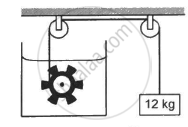Advertisements
Advertisements
प्रश्न
Observe the following diagram and answer the questions given below:

Specific heat capacity of metals
- Which element has maximum specific heat capacity? Justify.
- Which element has minimum specific heat capacity? Justify.
- Define specific heat of object.
उत्तर
- Maximum specific heat capacity is found in iron. The lead sphere absorbs less heat, which results in less heat transmission in the wax, so the sphere reaches the least depth into the wax in the activity. In contrast, the iron sphere absorbs more heat, which results in more heat transmission in the wax, so the sphere goes the deepest into the wax.
- A minimal specific heat capacity exists for lead. The lead spherical penetrates the wax the least because it absorbs less heat and transmits less heat to the wax.
- The amount of heat energy required to raise the temperature of a unit mass of an object by 1°C is called the specific heat of that object.
APPEARS IN
संबंधित प्रश्न
You have a choice of three metals A, B, and C, of specific heat capacities 900 Jkg-1 °C-1, 380 Jkg-1 °C-1 and 460 Jkg-1 °C-1 respectively, to make a calorimeter. Which material will you select? Justify your answer.
State two factors upon which the heat absorbed by a body depends
45 g of water at 50°C in a beaker is cooled when 50 g of copper at 18° C is added to it. The contents are stirred till a final constant temperature is reached. Calculate this final temperature. The specific heat capacity of copper is 0.39 J g-1K-1 and that of water is 4.2 J g-1K-1. State the assumption used.
Name the radiations for which the green house gases are transparent ?
Solve the following problems:
Equal heat is given to two objects A and B of mass 1 g. Temperature of A increases by 3°C and B by 5°C. Which object has more specific heat? And by what factor?
In Regnault's apparatus for measuring specific heat capacity of a solid, there is an inlet and an outlet in the steam chamber. The inlet is near the top and the outlet is near the bottom. Why is it better than the opposite choice where the inlet is near the bottom and the outlet is near the top?
Figure shows a paddle wheel coupled to a mass of 12 kg through fixed frictionless pulleys. The paddle is immersed in a liquid of heat capacity 4200 J K−1 kept in an adiabatic container. Consider a time interval in which the 12 kg block falls slowly through 70 cm. (a) How much heat is given to the liquid? (b) How much work is done on the liquid? (c) Calculate the rise in the temperature of the liquid neglecting the heat capacity of the container and the paddle.

The product of mass and specific heat is known as ..........
Fill in the following blank using suitable word:
SI unit of heat is .........
State the condition for the flow of heat energy from one body to another.
Is it possible to condense the water formed, back to ice by adding ice at 0°C. Explain with reason.
Give two reasons as to why copper is preferred over other metals for making calorimeters.
Write an expression for the heat energy liberated by a hot body.
1 kg of water freezes to form ice at 0°C. What amount of heat is withdrawn?
Derive an expression for finding out the specific heat capacity of a body (solid) from the readings of an experiment given below:
(i) Mass of empty calorimeter (with stirrer) = m1 gm
(ii) Mass of the metal piece = M gm
(iii) Mass of colorimeter and water = m2 gm
(iv) Initial temperature and water = t1°C
(v) Temperature of hot solid (metal piece) = t2 °C
(vi) Final temperature of the mixture = t°C
(vii) Specific heat of calorimeter = 0.4 J gm / °C
All metals have the same specific heat capacity.
Which of the substances P, Q, or R has the lowest specific heat? The temperature v/s time graph is shown ______.

A monoatomic gas of pressure 'P' having volume 'V' expands isothermally to a volume '2V' and then adiabatically to a volume '16V'. The final pressure of the gas is ______.
(ratio of specific heats = `5/3`)
Match the following:
| Column A | Column B | ||
| 1. | Specific heat capacity of water | a. | 0°C |
| 2. | Latent heat of fusion of ice | b. | 2260 J/g |
| 3. | Latent heat of vaporization of water | c. | 100°C |
| 4. | The melting point of iced | d. | 4.2 J/g°C |
| 5. | The boiling point of water | e. | 336 J/g |
